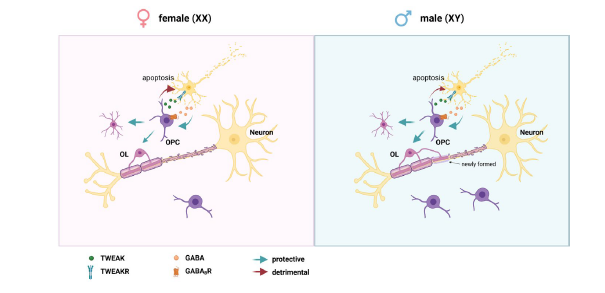
Hypothesis: GABABR/TWEAK signaling is beneficial for males but detrimental for females.
Principal Investigator
| Xianshu Bai |
|
School of Pharmacy, China Pharmaceutical University Email: xianshu.bai@cpu.edu.cn |
Group member
Name: Jie Zhao
Project title:
Sex-specific GABAB receptor signaling in oligodendrocyte lineage cells for remyelination
Geschlechtsspezifische GABAB-Rezeptor-Signalgebung in Zellen der Oligodendrozytenlinie für Remyelinisierung
Multiple sclerosis (MS) is the most prevalent autoimmune disease characterised by the destruction of the myelin sheath in the central nervous system (CNS), which disproportionately affects women. While the exact cause of MS remains unclear, the inability to generate new myelin is a key suspected factor.
In the CNS, myelin is produced exclusively by oligodendrocytes derived from precursor cells (OPCs). GABA, a prominent inhibitory neurotransmitter, stimulates OPC growth, migration and differentiation through GABAA and GABAB receptors. In MS patients, GABAergic function in the CNS is impaired, with loss of interneurons and reduced GABA levels. This interneuron loss may be linked to elevated levels of TWEAK (tumour necrosis factor-related weak inducer of apoptosis) in the plasma of MS patients. Our recent study suggests that TWEAK released by OPCs as a result of GABAB receptor activation triggers interneuron apoptosis. Strikingly, this TWEAK pathway benefits males but harms females in neonatal hypoxic-ischemic injury.
Preliminary results show that removing GABAB receptors from OPCs increases OPC/OL density of female but not male mice, during remyelination in a demyelination model. This suggests that manipulating GABABR/TWEAK signaling may help women with MS. Further research may identify novel interventions with sex-specific implications.
Publications:
1. Zhao J, Agarwal A*, Bai X* (2025). Glial Wnt dialogue controls synapses. Targetome. 1: e003
2. Fang LP, Zhao Y, Bai X (2025). Oligodendrocyte precursor cell-neuronal lysosomal pathway: A novel therapeutic target for neurodegenerative diseases. Neural Regen Res. Online print ahead. (Invited)
3. Fang LP, Lin CH, Medlej Y, Zhao R, Chang HF, Guo Q, Wu Z, Su Y, Zhao N, Gobbo D, Wyatt A, Wahl V, Fiore F, Tu SM, Boehm U, Huang W, Bian S, Agarwal A, Lauterbach MA, Yi C, Niu J, Scheller A, Kirchhoff F*, Bai X* (2025). Oligodendrocyte precursor cells facilitate neuronal lysosome release. Nat Commun. 16:1175.
4. Bai X (2024). Cytokine relay from the peripheral to the central – secrets behind fever. Acta Physiologica. 240:e14225. (Invited Editorial)
5. Haroon A, Seerapu H, Fang LP, Weß J, Bai X (2024). Unlocking the Potential: immune functions of oligodendrocyte precursor cells. Front Immunol. 15:1425706. (Invited Review)
6. Bai X. Multiple Sclerosis: Exploring Sex Differences and Beyond (2024). Neuroforum. 30: 21-29. (Invited Review)
7. Bai X*, Zhao N, Koupourtidou C, Fang LP, Schwarz V, Caudal LC, Zhao R, Hirrlinger J, Walz W, Bian S, Huang W, Ninkovic J, Kirchhoff F, Scheller A* (2023). After traumatic brain injury oligodendrocytes regain a plastic phenotype and can become astrocytes. Dev Cell. 58: 1153-1169. Selected as ‘DPG - Paper of the Month’ Juli 2023.
8. Fang LP, Bai X (2023). Implications of Olig2 silencing in oligodendrocyte precursor cells. Neural Regen Res. 18: 2649-2650. (Invited)
9. Fang LP, Bai X (2023). Oligodendrocyte precursor cells: the multitaskers in the brain. Pflugers Archiv. 475:1035-1044. (Invited Review)
10. Fang LP, Liu Q, Meyer E, Welle A, Huang W, Scheller A, Kirchhoff F*, Bai X* (2023). A subset of OPCs do not express Olig2 during development which can be increased in the adult by brain injuries and complex motor learning. Glia. 71: 415-430.
11. Fang LP, Zhao N, Caudal LC, Chang HF, Zhao R, Lin CH, Hainz N, Meier C, Bettler B, Huang W, Scheller A, Kirchhoff F*, Bai X* (2022). Impaired bidirectional communication between interneurons and oligodendrocyte precursor cells affects social cognitive behavior. Nat Commun 13: 1394. Selected as editor’s highlights in ‘From brain to behavior’ section.
12. Bai X, Kirchhoff F, Scheller A (2021). Oligodendroglial GABAergic signaling: more than inhibition! Neurosci Bull. 37: 1039-1050



